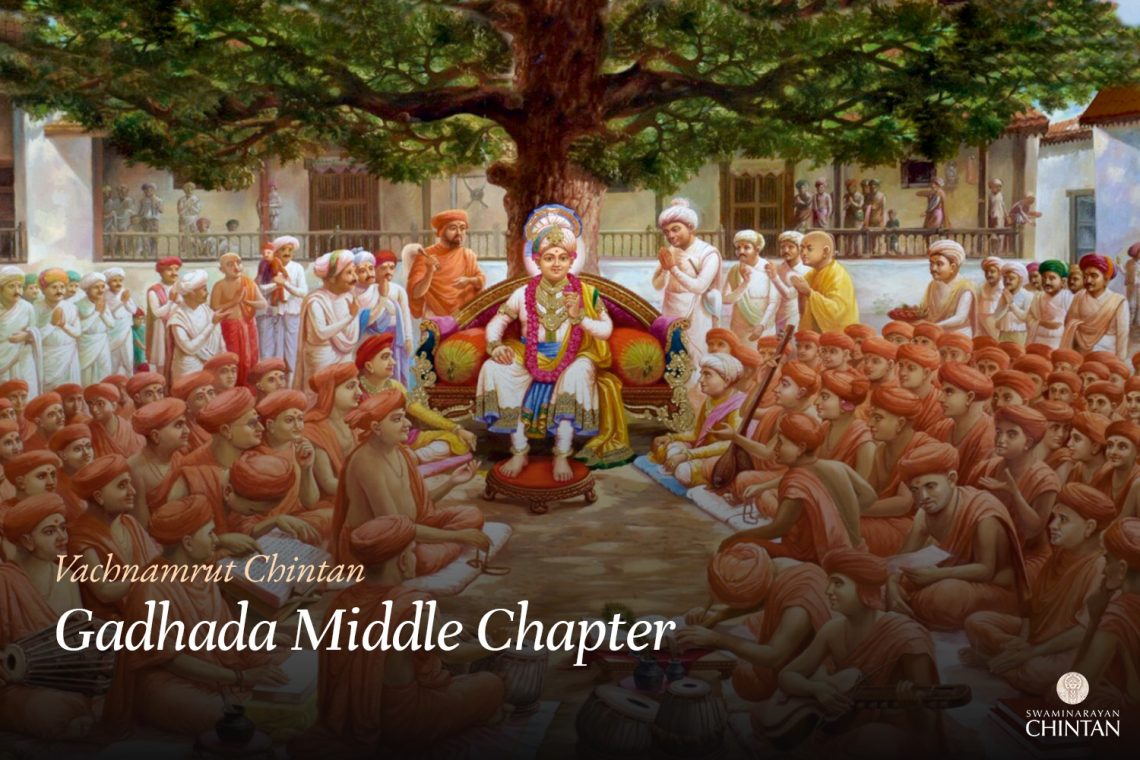Central Insights:
- The topic is about the Sagun and Nirgun qualities of Akshar.
Key Point:
- Bhagwan is neither Sagun nor Nirgun.
Explanation:
In this Vachanamrut, Bhagwadanand Swami asks Maharaj, “O Maharaj! How are infinite universes residing on each hair of Bhagwan’s body?” In the Bhagavatam, Brahmaji prays as follows:
क्वाहं तमोमहदहंखचराग्निवार्भूसंवेष्टिताण्डघटसप्तवितस्तिकायः ।
क्वैदद्विधाविगणिताण्डपराणुचर्च्यावातावरोमविवरस्य च ते महित्वम् ॥
Kvāhaṁ tamomahadahaṁ khacarāgnivārbhūsaṁveṣṭitāṇḍa-ghata-saptavitasti-kāyaḥ Kvaitad-vidhāvigaṇitāṇḍa-parāṇucaryā vātāvavāroma-vivarasya ca te mahitvam.
(Bhag. 10-14-11)
In this verse, Brahmaji says, “O Bhagwan! Infinite universes, encircled by eight coverings, reside in the pores of Your hair. Who am I in comparison to Your greatness?” The question posed here is how these universes can reside in a hair pore, as Bhagwan appears like a human being.
The second question is, “In which universes has Bhagwan incarnated?” Maharaj’s response implies that even though Bhagwan assumes a human form, both in His divine abode and on Earth, He possesses infinite power, strength, and divinity that far exceed anything in the universe.
Just as the vastness of Akshardham makes universes appear as small as dust particles, even though the universes remain as large as they are, the immense size of Akshar dwarfs them. Similarly, the vast Akshardham causes the universes to appear insignificantly small, though in reality, they retain their vastness. For example, while Mount Girnar is large, it appears small compared to Mount Meru, and even Mount Meru appears small compared to Lokalok. In this way, universes seem as small as atoms in comparison to the magnitude of Akshardham. This is why they are described as “atomic” in size, but they do not actually shrink; they just appear smaller due to the immense vastness of Akshar.
Maharaj explains that Akshar has two forms: Sagun (possessing the attributes of Maya) and Nirgun (beyond Maya’s attributes). In its Sagun form, Akshar is greater than anything large, and in its Nirgun form, it is subtler than the subtlest. Bhagwan, however, remains in a singular form and is neither classified as Sagun nor Nirgun. These attributes of Sagun and Nirgun belong to Aksharbrahm. Still, in Vach. Kariyani 8, Maharaj discusses Bhagwan’s Sagun-Nirgun form, explaining that these qualities—Sagun as the manifestation of extreme greatness and Nirgun as the manifestation of subtlety—are part of Bhagwan’s divine glory, but Bhagwan Himself transcends both.
Thus, Bhagwan’s glory may be understood as Sagun-Nirgun, or Aksharbrahm, His servant, may be defined as Sagun-Nirgun. However, Bhagwan transcends these qualities and governs over them. Where Paramatma resides is the center of Akshardham.
Just as the sun’s position defines all directions, Aksharbrahm defines all directions, with countless universes surrounding it in every direction, above and below. Bhagwan resides eternally in Akshardham and manifests whatever form He desires in any universe according to His will (Satyasankalp).
Glossary
| Akshar – Eternal Entity The highest spiritual reality beyond material existence, often associated with Bhagwan’ Swaminarayans divine abode. |
| Sagun – Possessing attributes of Maya |
| Nirgun – Beyond the three qualities of Maya |
| Akshardham – The eternal supreme abode of Bhagwan Swaminarayan The divine realm where Bhagwan Swaminarayan resides along with Akshar Muktas (Divine Liberated Souls) |
| Satyasankalp – The power of Bhagwan to manifest His will effortlessly |
| Panch Vishay – Five sensory objects The worldly temptations related to sight, sound, smell, taste, and touch. |
| Sagun-Nirgun Form – A manifestation of Bhagwan’s glory |
| Vishnupurana – A scripture focused on the glory of Vishnu and His devotees Highlights the consequences of offenses against Bhagwan’s devotees and the benefits of devotion and service. |
| Lokalok – A boundary of the universe described in scriptures Used to illustrate the relative vastness of Akshardham compared to other cosmic entities. |
| Aksharbrahm – The eternal and unchanging divine realm The supreme divine existence or state that is beyond the material world, often referenced in Swaminarayan philosophy. |

